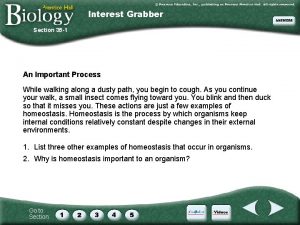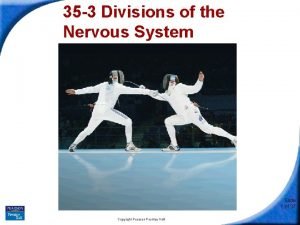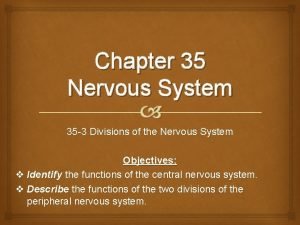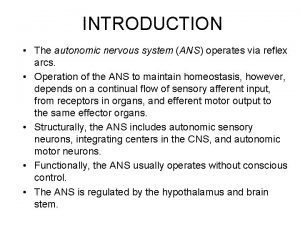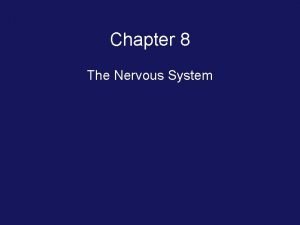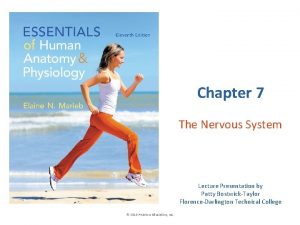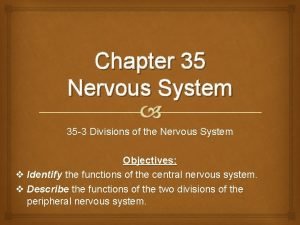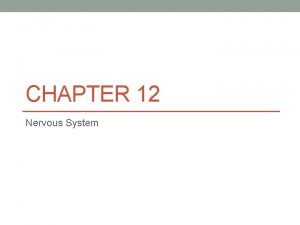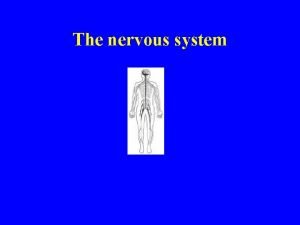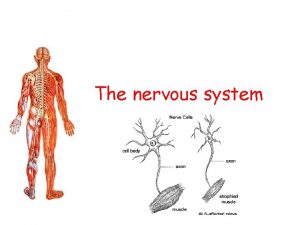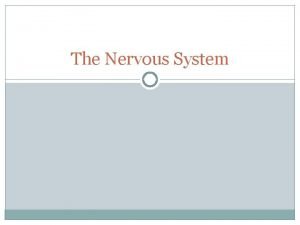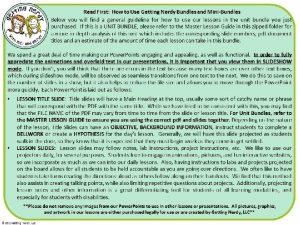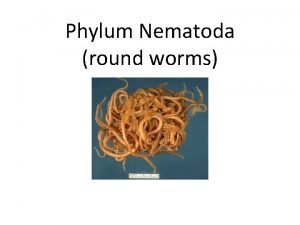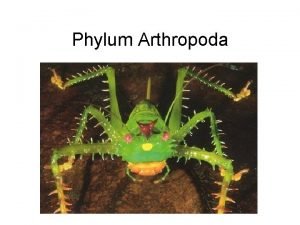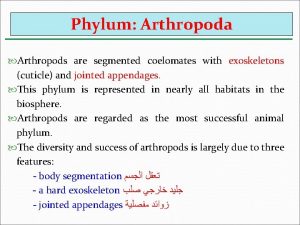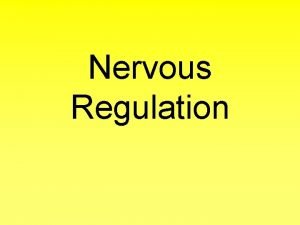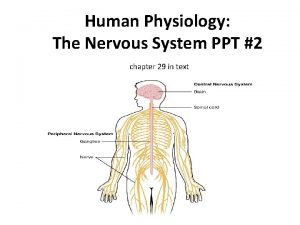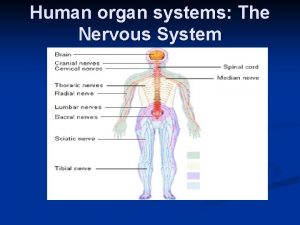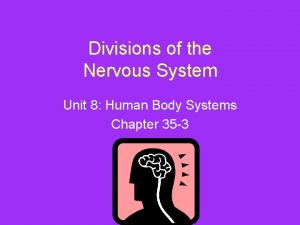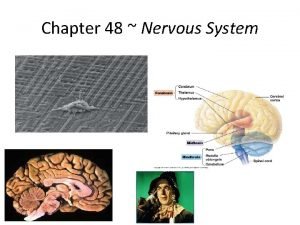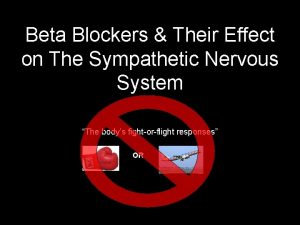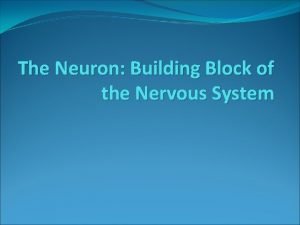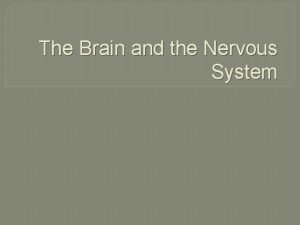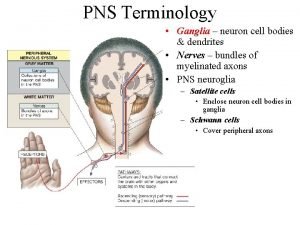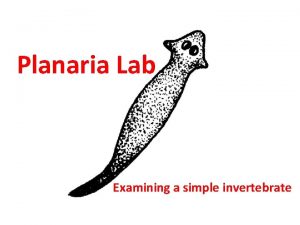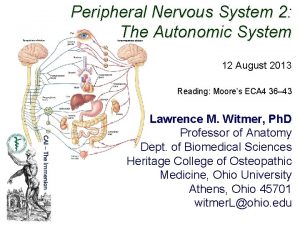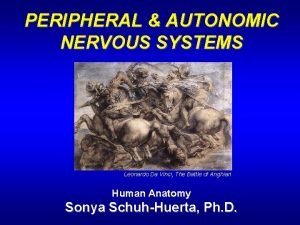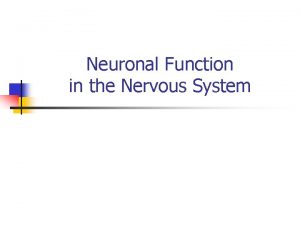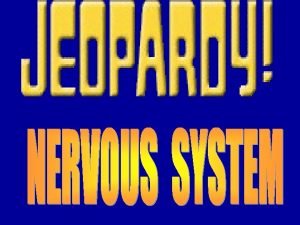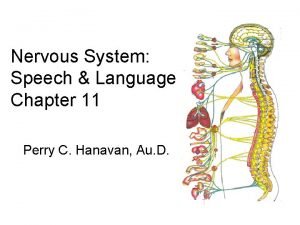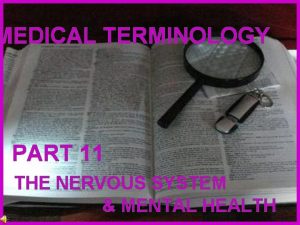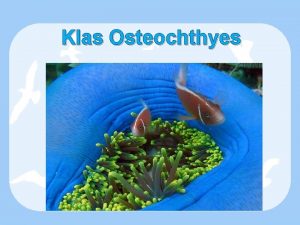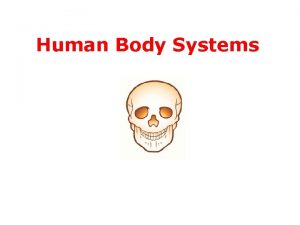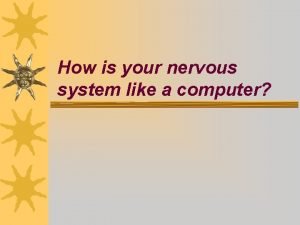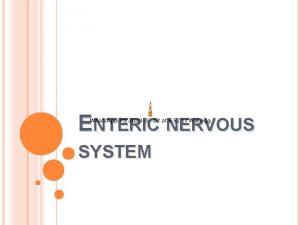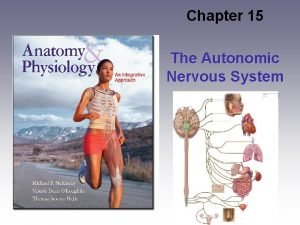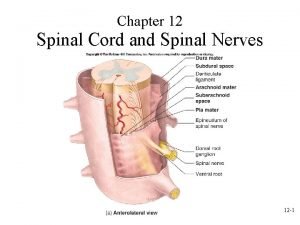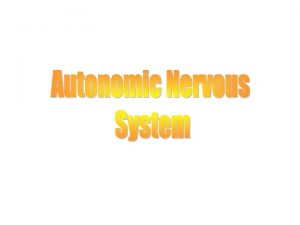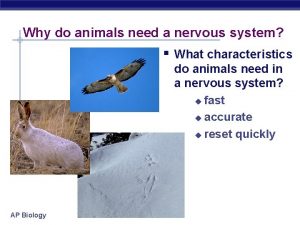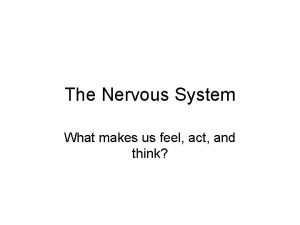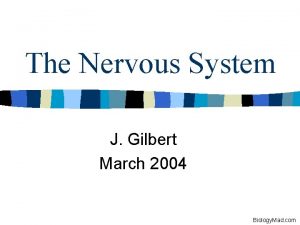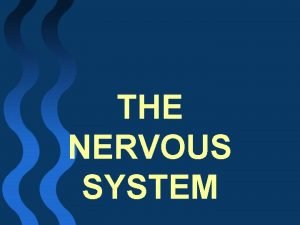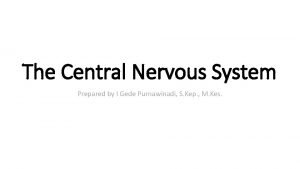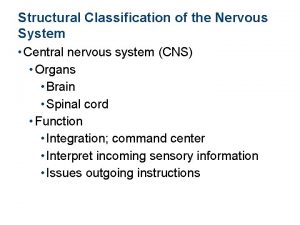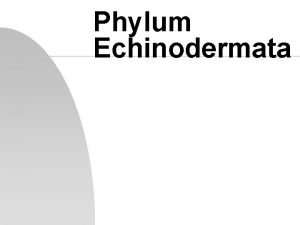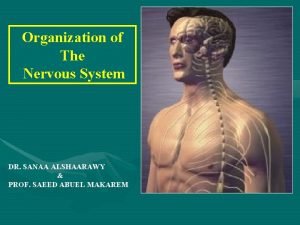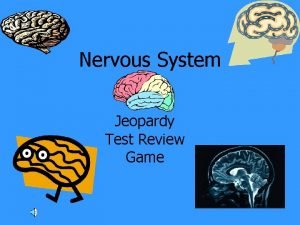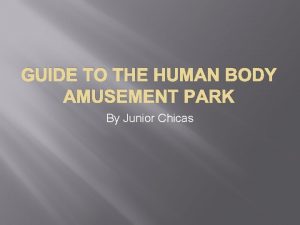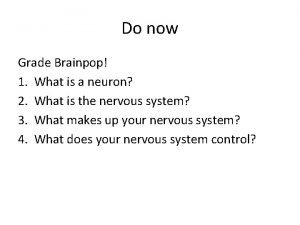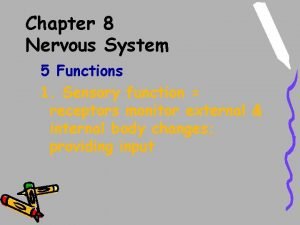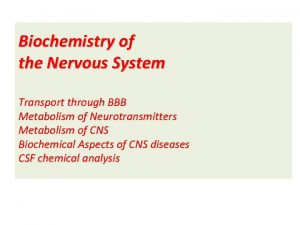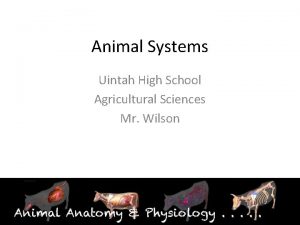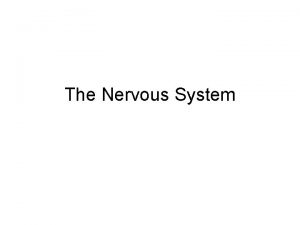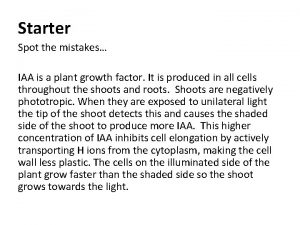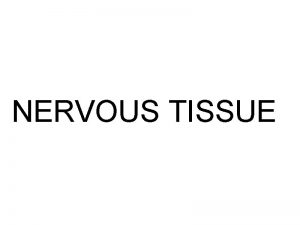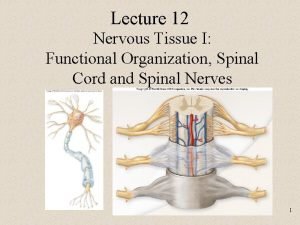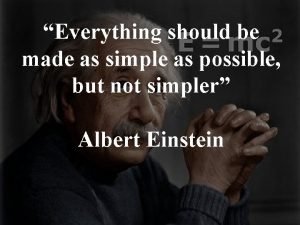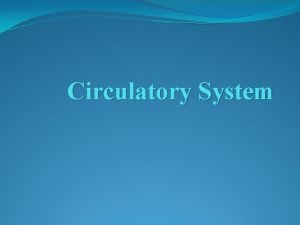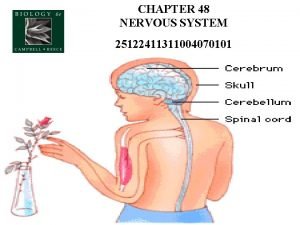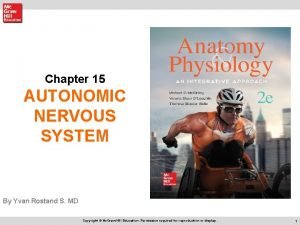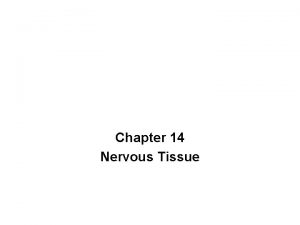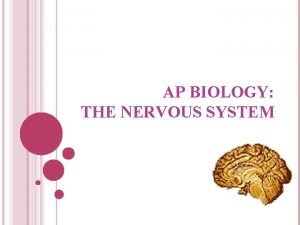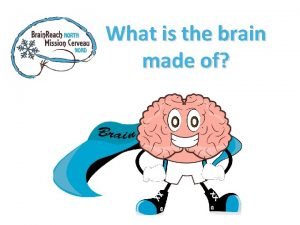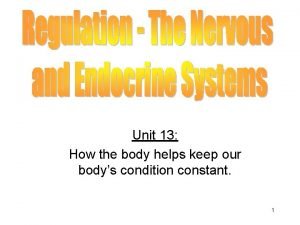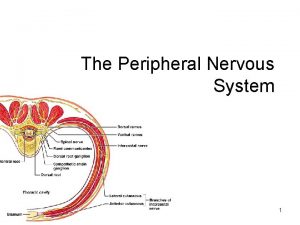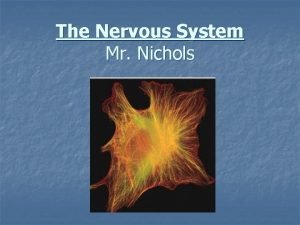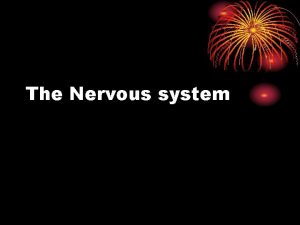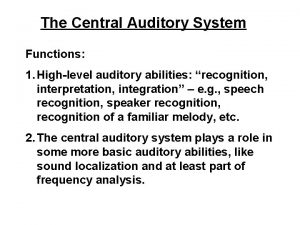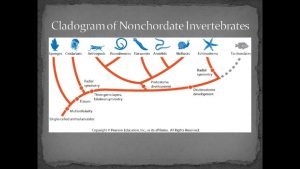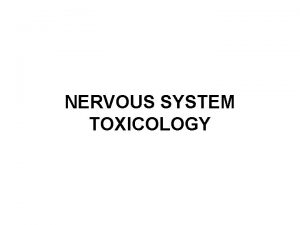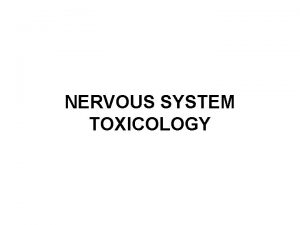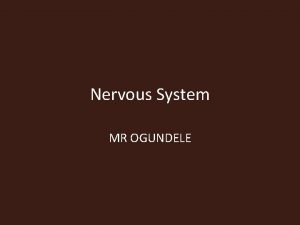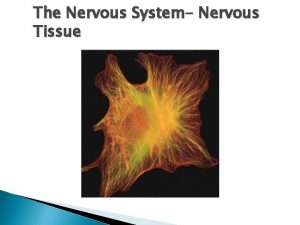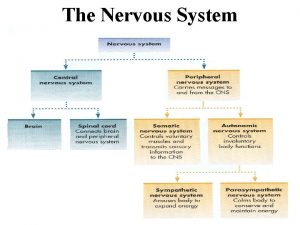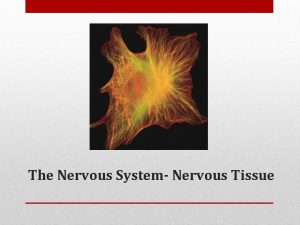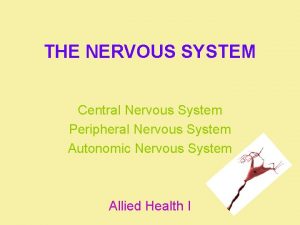Chapter Introduction Section 1 The Nervous System The





















































































![Roger Wolcott Sperry 1913– 1994 “In other words, each hemisphere [of the brain] seems Roger Wolcott Sperry 1913– 1994 “In other words, each hemisphere [of the brain] seems](https://slidetodoc.com/presentation_image/3facb771d221540edeb7571ca059112b/image-86.jpg)
































- Slides: 118


Chapter Introduction Section 1: The Nervous System: The Basic Structure Section 2: Studying the Brain Section 3: The Endocrine System Section 4: Heredity and Environment

Chapter Objectives · Section 1 The Nervous System: The Basic Structure Understand that the nervous system helps us know how messages that are sent to and from the brain cause behavior.

Chapter Objectives · Section 2 Studying the Brain Discuss the many parts of the brain that work together to coordinate movement and stimulate thinking and emotions.

Chapter Objectives · Section 3 The Endocrine System Explain how the endocrine system controls and excites growth and affects emotions and behavior.

Chapter Objectives · Section 4 Heredity and Environment Identify heredity and environment and analyze how they affect your body and behavior.


Main Idea Learning about the nervous system helps us know how messages that are sent to and from the brain cause behavior.

Vocabulary • central nervous system (CNS) • neurotransmitters • spinal cord • somatic nervous system (SNS) • peripheral nervous system (PNS) • automatic nervous system (ANS) • neurons • synapse

Lesson Essential Questions • What are the parts of the nervous system? • What are the functions of the nervous system?

What does the nervous system control? A. emotions B. movements C. thinking D. behavior A. B. C. D. A B C D

How the Nervous System Works • The nervous system controls your emotions, movements, thinking, and behavior—almost everything you do. • It is divided into two parts: – The central nervous system (CNS)—the brain and spinal cord. – The peripheral nervous system (PNS)— these small branches of nerves conduct information from the bodily organs to the CNS and take information back to the organs.

How the Nervous System Works (cont. ) • All parts of the nervous system are protected in some way (the skull protects the brain and so forth). The Nervous System

How the Nervous System Works (cont. ) • Neurons are the long, thin cells of nerve tissues along which messages travel to and from the brain (much like a flame travels along a firecracker fuse). • Transmission between neurons, or nerve cells, occurs whenever the cells are stimulated past a minimum point and emit a signal. Anatomy of Two Neurons

How the Nervous System Works (cont. ) • Neurons have four basic parts: – Dendrites – short, thin fibers that protrude from the cell body – Cell body – contains nucleus – An axon – carries impulses to axon terminals – Axon terminals – release neurotransmitters to stimulate dendrites of the next neuron

How the Nervous System Works (cont. ) • A white, fatty substance called the myelin sheath insulates and protects the axon from some neurons. • A synapse is a junction or connection between the neurons. The Synapse

How the Nervous System Works (cont. ) • A neuron transmits impulse or message to another neuron across the synapse by releasing neurotransmitters. – Neurotransmitters can excite the next neuron or stop it from transmitting. – The synapse only allows signals to move in one direction.

How the Nervous System Works (cont. ) • There are many different neurotransmitters including: – Norepinephrine – Endorphin – Acetylcholine – Dopamine – Serotonin

How the Nervous System Works (cont. ) • The actual destination of nerve impulses is limited by what tract in the nervous system they are on. – Ascending tracts carry sensory impulses to the brain. – Descending tracts carry motor impulses from the brain.

How the Nervous System Works (cont. ) • There are different types of neurons: – Afferent (sensory)—relay messages from the sense organs to the brain. – Efferent (motor)—send signals from the brain to the glands and muscles. – Interneurons—process signals connecting only to other neurons.

How the Nervous System Works (cont. ) • Somatic nervous system (SNS)—the part of the peripheral nervous system that controls voluntary movement of skeletal muscles. • Autonomic nervous system (ANS)—the part of the peripheral nervous system that controls involuntary internal biological functions.

How the Nervous System Works (cont. ) • The ANS has two parts: – The sympathetic nervous system— Prepares the body for dealing with emergencies or strenuous activity – The parasympathetic nervous system— Conserves energy and helps recover from strenuous activity

How many basic parts does a neuron have? A. one B. two C. three D. four A. B. C. D. A B C D

Bellwork • Read “Exploring Psychology” on p. 160. Answer: How did Hippocrates help change the notion that the brain, not the heart, was the source of thoughts and feelings?


Main Idea There are many parts in the human brain that work together to coordinate movement and stimulate thinking and emotions.

Vocabulary • hindbrain • midbrain • forebrain • lobes • positron emission tomography (PET) • magnetic resonance imaging (MRI) • electroencephalograph (EEG) • computerized axial tomography (CT)

Lesson Essential Questions • What are the structure and functions of the human brain? • In what different ways do psychologists study the brain?

How many general areas comprised the human brain? A. Two B. Three C. Four D. Five A. B. C. D. A B C D

The Three Brains • The brain is composed of three parts: – The hindbrain – The midbrain – The forebrain The Parts of the Brain

The Three Brains – The hindbrain – rear base of skull 1. cerebellum – located behind spinal cord – posture, balance, voluntary movements 2. medulla oblongata – located mid-brainstem below pons – breathing, heart rate, variety of reflexes 3. pons – located at top of brain stem – serves as bridge between spinal cord and brain – involved in producing sleep chemicals

The Three Brains – The midbrain – part of brain stem above the pons – integrates sensory information and relays it upward – nerve pathway of cerebral hemispheres – Brain stem = medulla, pons, midbrain – Reticular activating system (RAS) / Reticular Formation – spans across brain stem (medulla, pons, midbrain) – alerts the rest of the brain to incoming signals – involved in the sleep/wake cycle

The Three Brains (cont. ) • The higher thinking processes are located in the forebrain: – Cerebral cortex –Outer layer of forebrain –Learning, complex & abstract info. , thinking about future, see, read, understand language – Cerebrum –Inner layer of forebrain – The cerebral cortex and cerebrum surround the hindbrain and brain stem like a mushroom. – Limbic system – core of the forebrain, surrounded by cerebrum

The Three Brains (cont. ) • The limbic system (found in the core of the forebrain, surrounded by the cerebrum) includes the: – Hypothalamus – body temp. , thirst, hunger, sex – Amygdala – violent emotions – Thalamus – integration of sensory input – Hippocampus – formation of memories The Cerebral Cortex

The Three Brains (cont. ) • The cerebrum has two hemispheres connected by a band of fibers called the corpus callosum. • Each cerebral hemisphere has deep grooves, some of which mark regions, or lobes (the different regions into which the cerebral cortex is divided).

The Three Brains (cont. ) • There are four lobes: – Occipital lobe – vision – Parietal lobe – body sensations – Primary somatosensory cortex – front of parietal lobe, sense of touch – Temporal lobe – hearing, memory, emotion, speaking – Frontal lobe – organization, planning, thinking, judging right and wrong, personality – Primary motor cortex – back of frontal lobe, fine movement control

The Three Brains (cont. ) • The right and left hemispheres of the brain complement and help each other. • They are roughly mirror images of each other. Functions of the Brain’s Hemispheres

The Three Brains (cont. ) • Each hemisphere is connected to one-half the body in crisscrossed fashion (the right side of the brain controls the left side of the body and vice versa). Functions of the Brain’s Hemispheres

The Three Brains (cont. ) • The right side controls: – Visual and spatial relations – Perceptual tasks – Recognition of patterns – Creativity and intuition Functions of the Brain’s Hemispheres

The Three Brains (cont. ) • The left side controls: – Speech – Mathematical ability – Calculation – Logic Functions of the Brain’s Hemispheres

The Three Brains (cont. ) • Severing the corpus callosum can decrease the severity and amount of grand mal seizures a person is experiencing. • This results in a split brain—the person has two brains that operate independently of each other. Roger Wolcott Sperry

Which part of the brain controls your heart rate? A. Hindbrain B. Midbrain C. Forebrain A. A B. B C. C

How Psychologists Study the Brain • Psychologists who study the brain are known as physiological psychologists, psychobiologists, or neuroscientists.

How Psychologists Study the Brain (cont. ) • The methods used to explore the brain include: – Recording with an electroencephalograph (EEG) – Stimulation – Lesioning – Accidents

How Psychologists Study the Brain (cont. ) • Imaging is also used to study the brain: – Computerized axial tomography (CT) – Positron emission tomography (PET) – Magnetic resonance imaging (MRI) Brain Activity on a PET Scan

What Head Injuries Teach Us About the Brain

Ataxia is caused by injury to the…

Amnesia is caused by damage to the… Hippocampus

Urbach-Wiethe Disease involves hardening of the… A woman developed Urbach-Wiethe disease. Doctors were trying to diagnose her, and one of the tests they gave her was this one: to draw faces depicting certain emotions—happy, sad, etc. Which picture doesn’t look like the emotion it’s supposed to represent? This woman couldn’t draw what fear was. She also couldn’t recognize when people she was talking to were fearful. She also didn’t report experiencing much fear herself.

What is responsible for blindsight? If you walk up to a person with blindsight and say, “What color is my shirt? ” they’ll say they don’t know, they can’t see. However, if you then ask them to guess what hand you’re holding an item in, they guess right more often than not. Also, if you throw something toward a person with blindsight, they will sometimes dodge out of the way. People with blindsight have damaged the area of the brain responsible for processing vision information. These people’s eyes still work, and so do structures connected to their eyes. They just aren’t aware of what they’re seeing. It’s like when you hold someone’s eyes open while they’re Occipital Lobeasleep. They can see images, but they’re not aware of seeing them.

Damage to what part of the brain cause Wernicke’s Aphasia? “Word salad”: Temporal Lobe “It is so breakfast outside tonight. Sorry, my mother is laughing for dollhouse. I’m so quilted!”

What part of Phineas Gage’s brain was damaged? Frontal Lobe

Which method of studying the brain is the least likely to be used on humans? A. recording B. stimulating C. lesioning D. imaging A. B. C. D. A B C D


Main Idea The endocrine system controls and excites growth and affects emotions and behavior in people.

Vocabulary • endocrine system • hormones • pituitary gland

Lesson Essential Questions • What is the nature of the endocrine system? • What are hormones and what is their function in the endocrine system?

Have you experienced a situation in which your body responded by giving you a “rush”? A. Yes B. No C. Not sure A. A B. B C. C

The Endocrine Glands • The endocrine system is a chemical communication system that uses hormones to send messages through the bloodstream. • Hormones—chemical substances that carry messages through the body in blood. The Endocrine System

The Endocrine Glands (cont. ) • Hormones affect: – your behavior. – the growth of bodily structures such as muscles and bones. – your metabolic processes. – how your body acts in a stressful situation. – the brain (your moods and drives). – the differences between boys and girls.

The Endocrine Glands (cont. ) • The pituitary gland is the center of control of the endocrine system and secretes a large number of hormones. • It is directed by the hypothalamus.

The Endocrine Glands (cont. ) • These hormone messages regulate cell metabolism and control growth and reproduction. • The thyroid gland produces the hormone thyroxine, which stimulates certain chemical reactions that are important for all tissues of the body. • Too little thyroxine makes people feel lethargic (hypothyroidism). Too much causes weight-loss and loss of sleep (hyperthyroidism).

The Endocrine Glands (cont. ) • The adrenal glands become active when a person is angry or frightened. • They release epinephrine and norepinephrine, which cause the heartbeat and breathing to increase. • They heighten emotions, such as fear and anxiety. • They help generate the extra energy a person needs to handle a difficult situation.

The Endocrine Glands (cont. ) • There are two types of sex glands: – Testes—these produce sperm and testosterone. – Ovaries—these produce eggs and estrogen and progesterone.

Which of the following are some examples of duct glands? A. sweat glands B. tear glands C. salivary glands D. All of the above A. B. C. D. A B C D

Hormones Vs. Neurotransmitters • Neurotransmitter—a chemical used as a neurotransmitter is released right beside the cell that it is to excite or inhibit. • Over time, this system developed to send rapid and specific messages.

Hormones Vs. Neurotransmitters (cont. ) • Hormone—when a chemical is used as a hormone it is released into the blood, which diffuses it throughout the body. • Over time, this system developed to send slow and widespread communication.

Do you agree or disagree: Hormones are more useful to promote long-term change or stability in the body? A. Agree B. Disagree A. A B. B


Main Idea Heredity is the transmission of characteristics from parents to children. Environment is the world around you. Heredity and environment affect your body and behavior.

Vocabulary • heredity • identical twins • genes • fraternal twins

Lesson Essential Questions • What are some examples of the effects of heredity and environment on behavior? • What does research say about the effects of heredity and environment on behavior?

Heredity and Environment • Most psychologists agree that both nature and nurture contribute to human behavior. • Nature refers to the characteristics that person inherits—his or her biological makeup.

Heredity and Environment (cont. ) • Nature is also referred to as heredity, or the genetic transmission of characteristics from parents to their offspring through genes. • Nurture refers to environmental factors, such as family, culture, education. DNA and Genes

Heredity and Environment (cont. ) • One way to find out if a trait is inherited is to study twins. – Identical twins develop from a single fertilized egg (also called monozygotic) and share the same genes. – Fraternal twins come from two different eggs fertilized by two different sperm (also called dizygotic).


The Nervous System The nervous system is divided into two parts: the central nervous system (CNS) and the peripheral nervous system (PNS).

Anatomy of Two Neurons The human body contains billions of neurons. The neuron receives messages from other neurons via its dendrites. The messages are then transmitted down the axon and sent out through the axon terminals. The myelin sheath often is wrapped around the axon. Photomicrograph of neurons

The Synapse Neurons do not touch one another. Instead, a neuron sends its messages across a gap called a synapse by releasing neurotransmitters. These neurotransmitters are received by the dendrite of another neuron.

The Parts of the Brain The brain is the largest, most complex part of the nervous system.

The Cerebral Cortex The functions of the cerebral cortex are not fully understood. Indicated here are some areas of behavioral importance.

Functions of the Brain’s Hemispheres The idea of whether we are “right-brained” or “left-brained” has been exaggerated. We constantly use both hemispheres of our brain, since each hemisphere is specialized for processing certain kinds of information.

Brain Activity on a PET Scan A computer transforms the different levels of absorption by neurons of radioactive solution into colors. Red and yellow indicate maximum activity of neurons, while blue and green indicate minimal activity.

The Endocrine System The endocrine system, which consists of ductless glands and the hormones they produce, works closely with the nervous system in regulating body functions.

DNA and Genes The molecules of DNA make up chromosomes that contain the codes for our biological makeup.
![Roger Wolcott Sperry 1913 1994 In other words each hemisphere of the brain seems Roger Wolcott Sperry 1913– 1994 “In other words, each hemisphere [of the brain] seems](https://slidetodoc.com/presentation_image/3facb771d221540edeb7571ca059112b/image-86.jpg)
Roger Wolcott Sperry 1913– 1994 “In other words, each hemisphere [of the brain] seems to have its own separate and private sensations; its own perceptions; its own concepts; and its own impulses to act. . Following surgery, each hemisphere also has thereafter its own separate chain of memories that are rendered inaccessible to the recall processes of the other. ”

Chapter Concepts Transparencies Types of Neurotransmitters Functions of the Somatic Nervous System Select a transparency to view.







central nervous system (CNS): the brain and spinal cord

spinal cord: nerves that run up and down the length of the back and transmit most messages between the body and the brain

peripheral nervous system (PNS): nerves branching beyond the spinal cord into the body

neurons: the long, thin cells of nerve tissue along which messages travel to and from the brain

synapse: the gap that exists between individual nerve cells

neurotransmitters: the chemicals released by neurons, which determine the rate at which other neurons fire

somatic nervous system (SNS): the part of the peripheral nervous system that controls voluntary movement of skeletal muscles

automatic nervous system (ANS): the part of the peripheral nervous system that controls

hindbrain: a part of the brain located at the rear base of the skull that is involved in the basic processes of life

midbrain: a small part of the brain above the pons that arouses the brain, integrates sensory information, and relays it upward

forebrain: a part of the brain that covers the brain’s central core, responsible for sensory and motor control and the processing of thinking and language

lobes: the different regions into which the cerebral cortex is divided

electroencephalograph (EEG): a machine used to record the electrical activity of large portions of the brain

computerized axial tomography (CT): an imaging technique used to study the brain to pinpoint injuries and brain deterioration

positron emission tomography (PET): an imaging technique used to see which brain areas are being activated while performing tasks

magnetic resonance imaging (MRI): a measuring technique used to study brain structure and activity

endocrine system: a chemical communication system, using hormones, by which messages are sent through the bloodstream

hormones: chemical substances that carry messages through the body in blood

pituitary gland: the center of control of the endocrine system that secretes a large number of hormones

heredity: the genetic transmission of characteristics from parents to their offspring

identical twins: twins who come from one fertilized egg; twins having the same heredity

genes: the basic building blocks of heredity

fraternal twins: twins who come from two different eggs fertilized by two different sperm

To use this Presentation Plus! product: Click the Forward button to go to the next slide. Click the Previous button to return to the previous slide. Click the Home button to return to the Chapter Menu. Click the Transparency button from the Chapter Menu or Chapter Introduction slides to access the Concept Transparencies that are relevant to this chapter. From within a section, click on this button to access the relevant Daily Focus Skills Transparency. Click the Return button in a feature to return to the main presentation. Click the Psychology Online button to access online textbook features. Click the Exit button or press the Escape key [Esc] to end the chapter slide show. Click the Help button to access this screen. Links to Presentation Plus! features such as Profiles in Psychology and relevant figures from your textbook are located at the bottom of relevant screens.

This slide is intentionally blank.
 Fundamentals of the nervous system and nervous tissue
Fundamentals of the nervous system and nervous tissue Nervous
Nervous Fundamentals of the nervous system and nervous tissue
Fundamentals of the nervous system and nervous tissue Section 35-1 human body systems answer key
Section 35-1 human body systems answer key Section 35-3 divisions of the nervous system
Section 35-3 divisions of the nervous system Section 35-3 divisions of the nervous system
Section 35-3 divisions of the nervous system Ans
Ans Nervous system and digestive system
Nervous system and digestive system Endocrine system and nervous system
Endocrine system and nervous system Endocrine vs nervous system venn diagram
Endocrine vs nervous system venn diagram Endocrine system and nervous system
Endocrine system and nervous system Bipolar neuron function
Bipolar neuron function Chapter 15 nervous system diseases and disorders
Chapter 15 nervous system diseases and disorders Chapter 8 the nervous system
Chapter 8 the nervous system Chapter 7 the nervous system figure 7-2
Chapter 7 the nervous system figure 7-2 Chapter 35 nervous system
Chapter 35 nervous system Chapter 14 skeletal muscular and nervous systems
Chapter 14 skeletal muscular and nervous systems Chapter 12 nervous system
Chapter 12 nervous system Chemical messengers of the nervous system
Chemical messengers of the nervous system Is flatworms asexual reproduction
Is flatworms asexual reproduction The nervous system is made up of
The nervous system is made up of Primary functions of the nervous system
Primary functions of the nervous system Nervous system learning objectives
Nervous system learning objectives What is stimuli in nervous system
What is stimuli in nervous system Spinal cord structure
Spinal cord structure Nerve ganglia
Nerve ganglia Parasympathetic nervous system def
Parasympathetic nervous system def Spinal nerve pairs
Spinal nerve pairs Sns somatic nervous system
Sns somatic nervous system The nervous system brain scienstructable
The nervous system brain scienstructable Autonomic nervous system pathway
Autonomic nervous system pathway Phylum
Phylum Phylum arthropoda marine
Phylum arthropoda marine Jointed foot phylum
Jointed foot phylum Segmented coelomates
Segmented coelomates Major division
Major division Ans
Ans Coelenterates nervous system
Coelenterates nervous system Autonomic nervous system consists of
Autonomic nervous system consists of The body's speedy electrochemical communication network
The body's speedy electrochemical communication network Ans
Ans Human nervous system ppt
Human nervous system ppt Basic unit of nervous system
Basic unit of nervous system The basic unit of the nervous system is the
The basic unit of the nervous system is the Ppt
Ppt White matter
White matter Comparison of endocrine and nervous system
Comparison of endocrine and nervous system 8 divisions of the nervous system
8 divisions of the nervous system How to take care of your nervous system
How to take care of your nervous system Nervous system effector cells
Nervous system effector cells Are endocrine glands ductless
Are endocrine glands ductless Beta-blockers for overactive sympathetic nervous system
Beta-blockers for overactive sympathetic nervous system Neurotransmitter in somatic nervous system
Neurotransmitter in somatic nervous system Spinal cord dorsal and ventral roots
Spinal cord dorsal and ventral roots Digestive system of silkworm diagram
Digestive system of silkworm diagram What is the building block of the nervous system
What is the building block of the nervous system Structure of nervous system graphic organizer
Structure of nervous system graphic organizer Ganglion peripheral nervous system
Ganglion peripheral nervous system Planaria kingdom
Planaria kingdom What are the two body forms of cnidarians?
What are the two body forms of cnidarians? Rami ventralis
Rami ventralis Sympathetic and parasympathetic nervous system difference
Sympathetic and parasympathetic nervous system difference Learning objectives of nervous system
Learning objectives of nervous system Divisions of the nervous system
Divisions of the nervous system Nervous system speech
Nervous system speech Nervous system vocabulary
Nervous system vocabulary Disorders of the nervous system
Disorders of the nervous system Ikan bertulang sejati adalah
Ikan bertulang sejati adalah How the nervous system works
How the nervous system works Nervous system of computer
Nervous system of computer Enteric nervous system
Enteric nervous system Adrenal nervous system
Adrenal nervous system Men in goh seel
Men in goh seel Autonomic nervous system
Autonomic nervous system Functional unit of nervous system
Functional unit of nervous system Body system theme park project
Body system theme park project The autonomic nervous system controls
The autonomic nervous system controls Why do animals need a nervous system
Why do animals need a nervous system Enmeshment
Enmeshment Nervous system function
Nervous system function The human nervous system biology mad
The human nervous system biology mad Somatic nervous system
Somatic nervous system Classification of nervous system
Classification of nervous system Cerebral aqueduct
Cerebral aqueduct Brittle stars phylum
Brittle stars phylum Classification of nervous system
Classification of nervous system Jeopardy nervous system
Jeopardy nervous system Central nervous system amusement park
Central nervous system amusement park Skeletal system amusement park
Skeletal system amusement park Brainpop nervous system
Brainpop nervous system Neuroglia
Neuroglia Biochemistry of nervous system
Biochemistry of nervous system What is the job of the nervous system
What is the job of the nervous system Peripheral nervous system
Peripheral nervous system Organisation of nervous system
Organisation of nervous system Nodes of ranvier
Nodes of ranvier Central. nervous system
Central. nervous system Components of nervous system
Components of nervous system Functional nervous system
Functional nervous system Plane name
Plane name Functional organisation of nervous system
Functional organisation of nervous system Nervous system homeostasis
Nervous system homeostasis Autonomic dysreflexia
Autonomic dysreflexia Neurolemmocyte
Neurolemmocyte Ap biology nervous system
Ap biology nervous system Nervous system
Nervous system Tour of body.com
Tour of body.com Nervous system
Nervous system Saphenous nerve plexus
Saphenous nerve plexus Nervous system cartoons
Nervous system cartoons Nervous system concept map simple
Nervous system concept map simple Hydra neurons
Hydra neurons Nervous system tract
Nervous system tract Bser aer
Bser aer Peripheral nervous system consists of
Peripheral nervous system consists of Youtub.eoc
Youtub.eoc Vissoral
Vissoral What is the spinal cord made of
What is the spinal cord made of Classification of sensory receptors
Classification of sensory receptors



